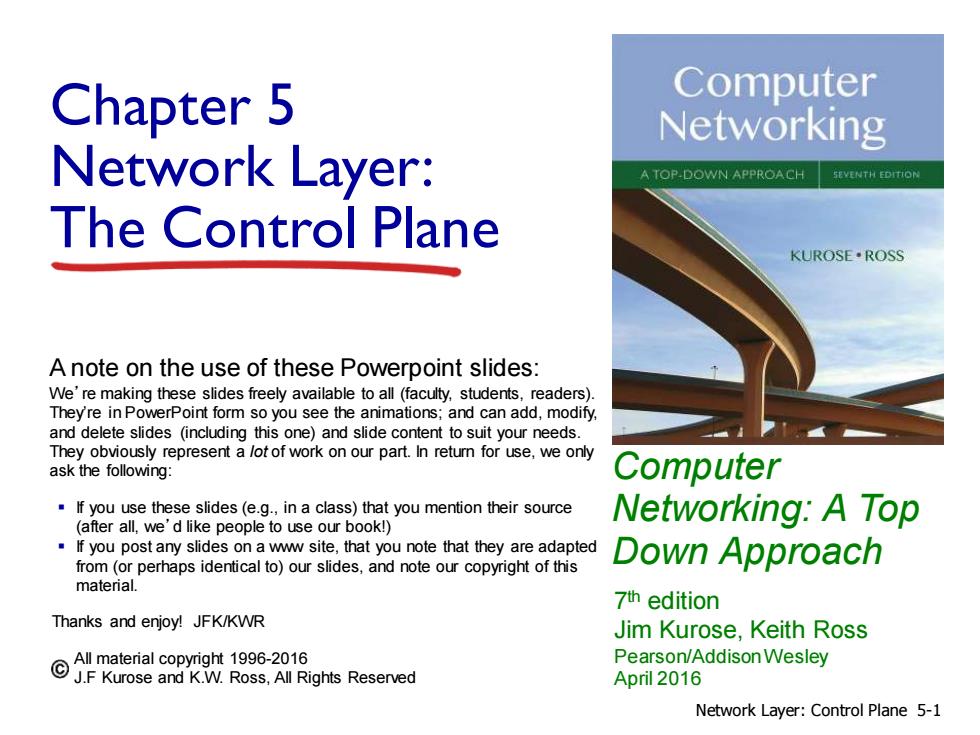
Chapter 5 Computer Networking Network Layer: A TOP-DOWN APPROACH SEVENTH EDITION The Control Plane KUROSE·ROSS A note on the use of these Powerpoint slides: We're making these slides freely available to all(faculty,students,readers). They're in PowerPoint form so you see the animations;and can add,modify, and delete slides (including this one)and slide content to suit your needs. They obviously represent a lot of work on our part.In retum for use,we only ask the following: Computer If you use these slides (e.g.,in a class)that you mention their source Networking:A Top (after all,we'd like people to use our book!) If you post any slides on a ww site,that you note that they are adapted from(or perhaps identical to)our slides,and note our copyright of this Down Approach material. 7th edition Thanks and enjoy!JFK/KWR Jim Kurose,Keith Ross mResenved Pearson/Addison Wesley April 2016 Network Layer:Control Plane 5-1
Computer Networking: A Top Down Approach A note on the use of these Powerpoint slides: We’re making these slides freely available to all (faculty, students, readers). They’re in PowerPoint form so you see the animations; and can add, modify, and delete slides (including this one) and slide content to suit your needs. They obviously represent a lot of work on our part. In return for use, we only ask the following: ▪ If you use these slides (e.g., in a class) that you mention their source (after all, we’d like people to use our book!) ▪ If you post any slides on a www site, that you note that they are adapted from (or perhaps identical to) our slides, and note our copyright of this material. Thanks and enjoy! JFK/KWR All material copyright 1996-2016 J.F Kurose and K.W. Ross, All Rights Reserved 7 th edition Jim Kurose, Keith Ross Pearson/Addison Wesley April 2016 Chapter 5 Network Layer: The Control Plane Network Layer: Control Plane 5-1
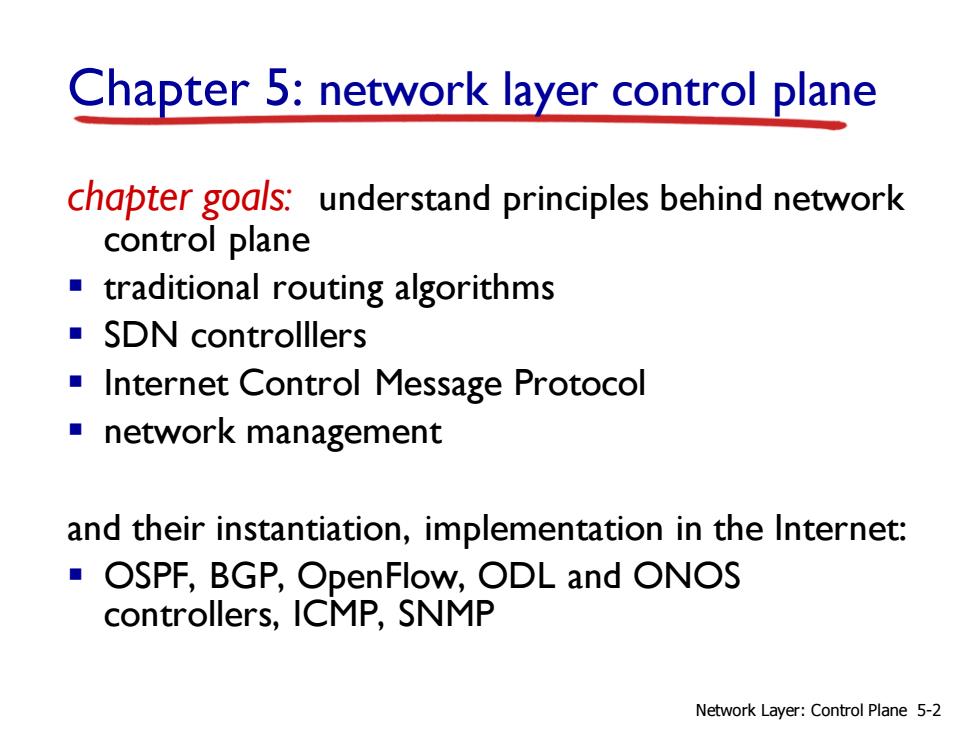
Chapter 5:network layer control plane chapter goals:understand principles behind network control plane traditional routing algorithms SDN controlllers Internet Control Message Protocol network management and their instantiation,implementation in the Internet: ■ OSPF,BGP,OpenFlow,ODL and ONOS controllers,ICMP,SNMP Network Layer:Control Plane 5-2
Chapter 5: network layer control plane chapter goals: understand principles behind network control plane ▪ traditional routing algorithms ▪ SDN controlllers ▪ Internet Control Message Protocol ▪ network management and their instantiation, implementation in the Internet: ▪ OSPF, BGP, OpenFlow, ODL and ONOS controllers, ICMP, SNMP Network Layer: Control Plane 5-2
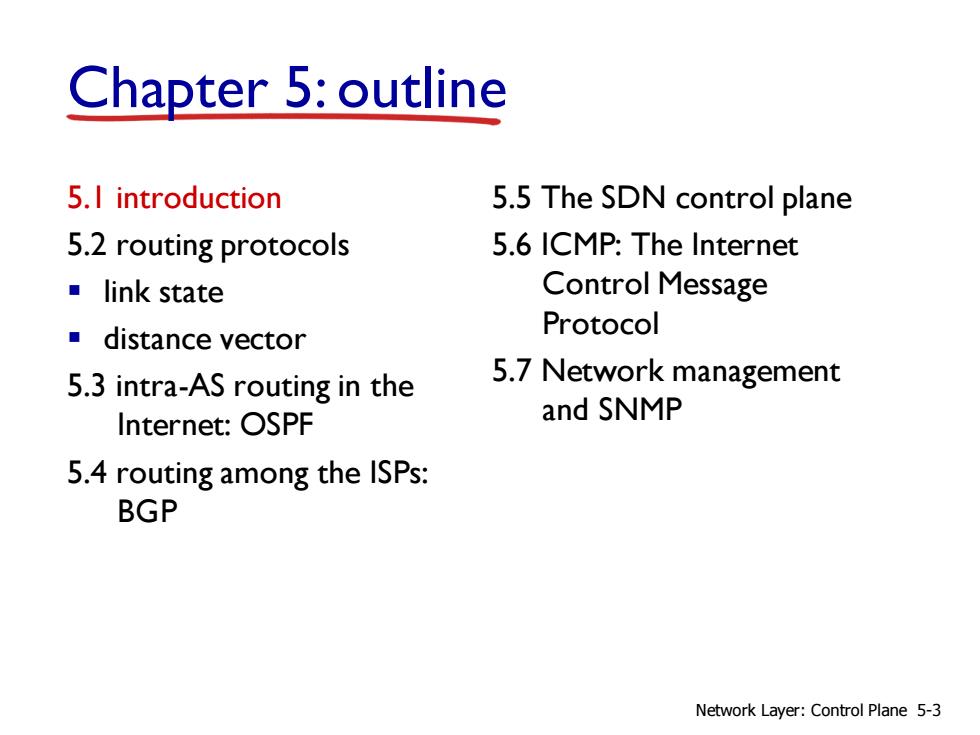
Chapter 5:outline 5.I introduction 5.5 The SDN control plane 5.2 routing protocols 5.6 ICMP:The Internet ■link state Control Message ■distance vector Protocol 5.3 intra-AS routing in the 5.7 Network management Internet:OSPF and SNMP 5.4 routing among the ISPs: BGP Network Layer:Control Plane 5-3
5.1 introduction 5.2 routing protocols ▪ link state ▪ distance vector 5.3 intra-AS routing in the Internet: OSPF 5.4 routing among the ISPs: BGP 5.5 The SDN control plane 5.6 ICMP: The Internet Control Message Protocol 5.7 Network management and SNMP Chapter 5: outline Network Layer: Control Plane 5-3
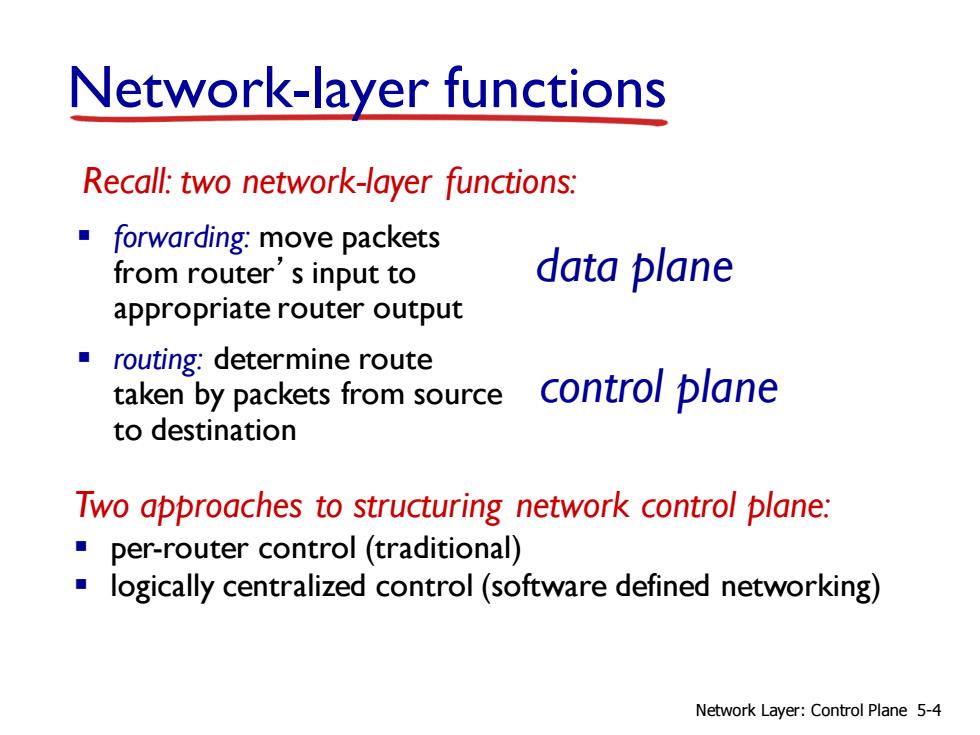
Network-layer functions Recall:two network-layer functions: forwarding:move packets from router's input to data plane appropriate router output routing:determine route taken by packets from source control plane to destination Two approaches to structuring network control plane: per-router control(traditional) logically centralized control(software defined networking) Network Layer:Control Plane 5-4
Network-layer functions ▪ forwarding: move packets from router’s input to appropriate router output data plane control plane Two approaches to structuring network control plane: ▪ per-router control (traditional) ▪ logically centralized control (software defined networking) Recall: two network-layer functions: Network Layer: Control Plane 5-4 ▪ routing: determine route taken by packets from source to destination
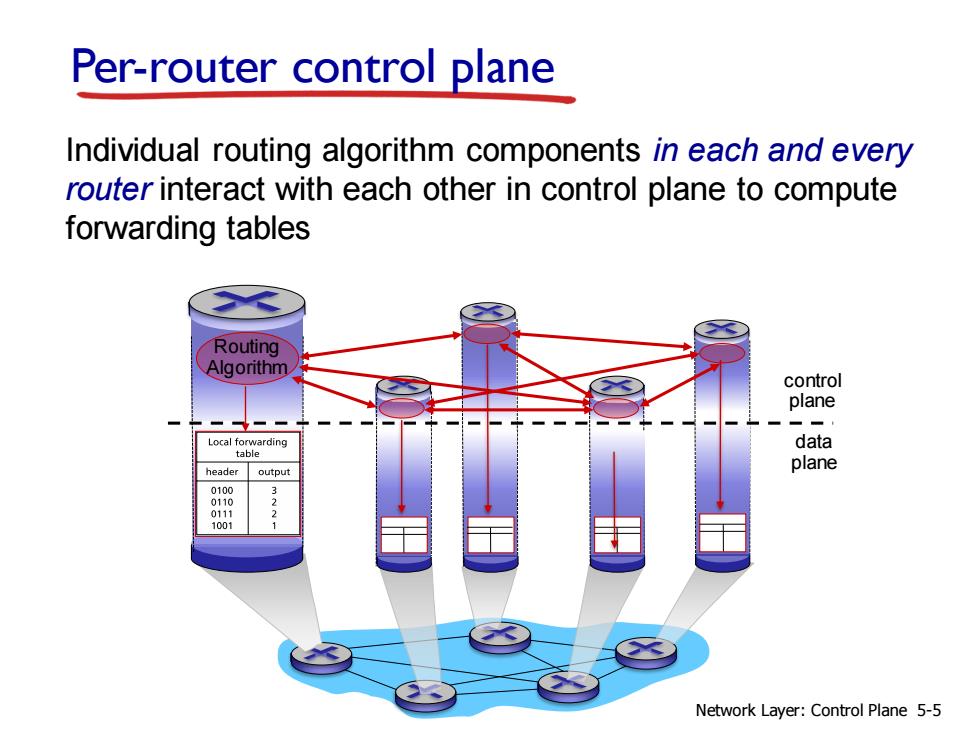
Per-router control plane Individual routing algorithm components in each and every router interact with each other in control plane to compute forwarding tables Routing Algorithm control plane data header output plane 8198 901 Network Layer:Control Plane 5-5
Per-router control plane Routing Algorithm Individual routing algorithm components in each and every router interact with each other in control plane to compute forwarding tables data plane control plane Network Layer: Control Plane 5-5
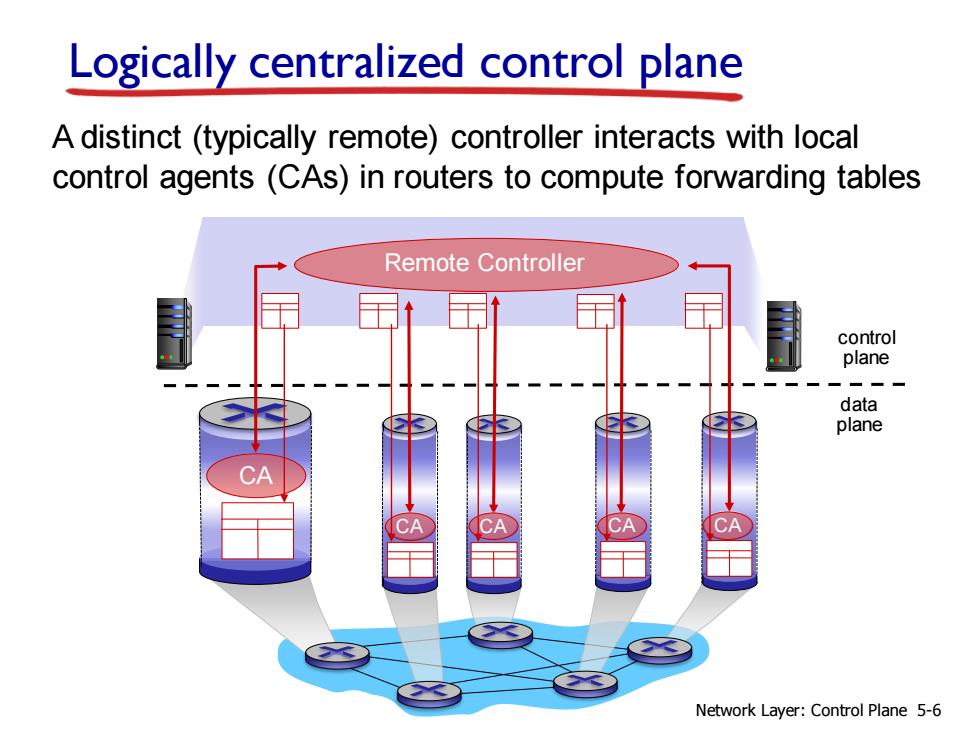
Logically centralized control plane A distinct (typically remote)controller interacts with local control agents(CAs)in routers to compute forwarding tables Remote Controller control plane data plane A Network Layer:Control Plane 5-6
data plane control plane Logically centralized control plane A distinct (typically remote) controller interacts with local control agents (CAs) in routers to compute forwarding tables Remote Controller CA CA CA CA CA Network Layer: Control Plane 5-6

Chapter 5:outline 5.I introduction 5.5 The SDN control plane 5.2 routing protocols 5.6 ICMP:The Internet ■link state Control Message distance vector Protocol 5.3 intra-AS routing in the 5.7 Network management Internet:OSPF and SNMP 5.4 routing among the ISPs: BGP Network Layer:Control Plane 5-7
5.1 introduction 5.2 routing protocols ▪ link state ▪ distance vector 5.3 intra-AS routing in the Internet: OSPF 5.4 routing among the ISPs: BGP 5.5 The SDN control plane 5.6 ICMP: The Internet Control Message Protocol 5.7 Network management and SNMP Chapter 5: outline Network Layer: Control Plane 5-7
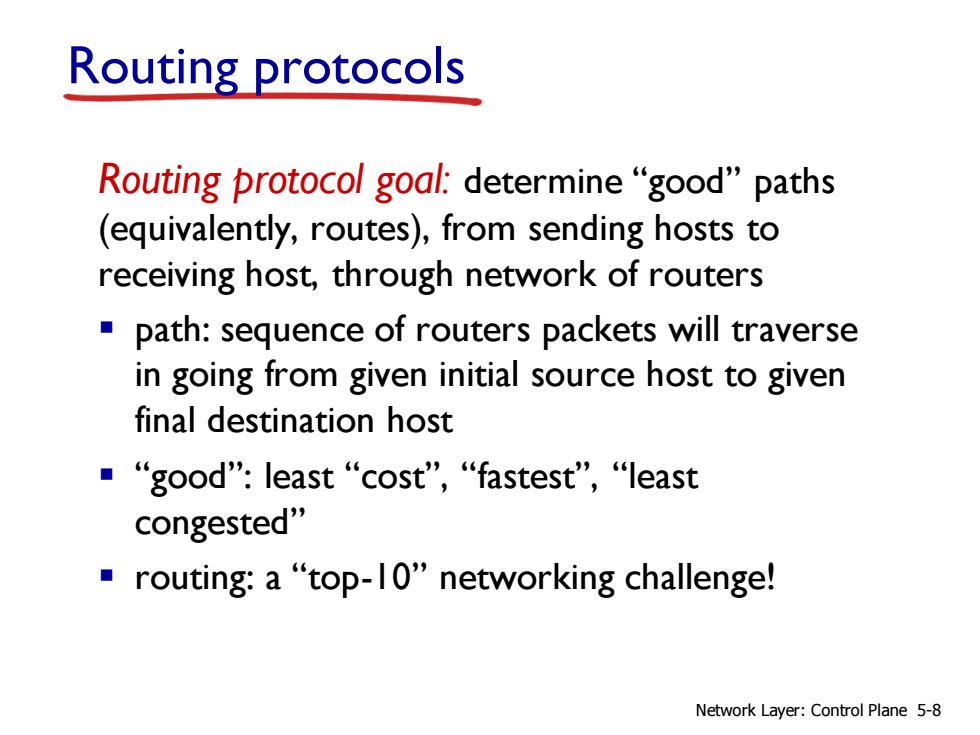
Routing protocols Routing protocol goal:determine"good"paths (equivalently,routes),from sending hosts to receiving host,through network of routers path:sequence of routers packets will traverse in going from given initial source host to given final destination host ■“good':least“cost”,“fastest'”,“least congested" ■routing:a“top-lO'networking challenge! Network Layer:Control Plane 5-8
Routing protocols Routing protocol goal: determine “good” paths (equivalently, routes), from sending hosts to receiving host, through network of routers ▪ path: sequence of routers packets will traverse in going from given initial source host to given final destination host ▪ “good”: least “cost”, “fastest”, “least congested” ▪ routing: a “top-10” networking challenge! Network Layer: Control Plane 5-8
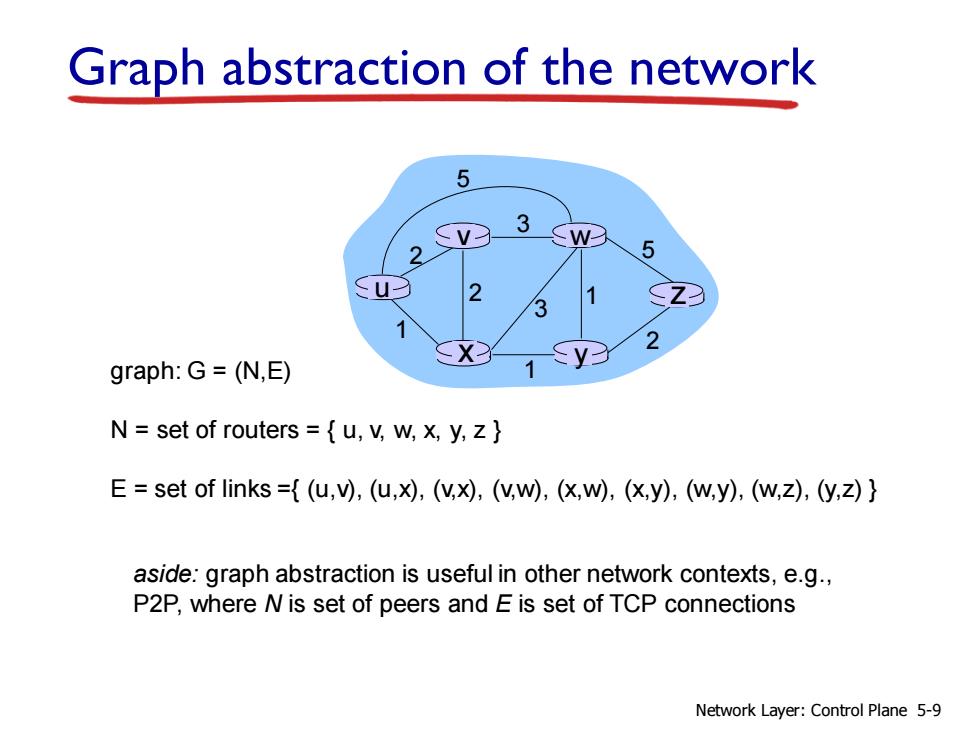
Graph abstraction of the network 5 W- 2 graph:G=(N,E) N=set of routers={u,v,w,x,y,Z} E=set of links={(u,v),(u,x),(v,x),(v,w),(x,w),(x,y),(w,y),(w,z),(y,Z)} aside:graph abstraction is useful in other network contexts,e.g., P2P,where Nis set of peers and E is set of TCP connections Network Layer:Control Plane 5-9
u x y v w z 2 2 1 3 1 1 2 5 3 5 graph: G = (N,E) N = set of routers = { u, v, w, x, y, z } E = set of links ={ (u,v), (u,x), (v,x), (v,w), (x,w), (x,y), (w,y), (w,z), (y,z) } Graph abstraction of the network aside: graph abstraction is useful in other network contexts, e.g., P2P, where N is set of peers and E is set of TCP connections Network Layer: Control Plane 5-9
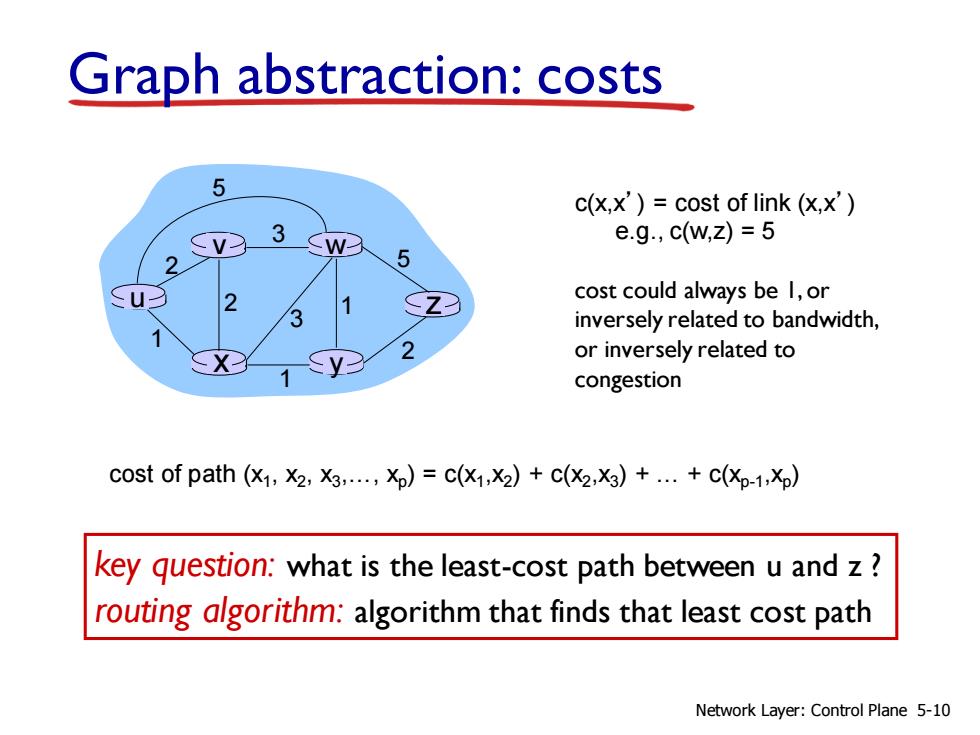
Graph abstraction:costs 5 c(x,x')=cost of link (x,x') 3 W e.g,c(w,z)=5 5 cost could always be l,or inversely related to bandwidth, or inversely related to congestion cost of path (X1,X2,X3....,Xp)=c(x1,X2)c(x2.X3)+...+c(Xp-1,Xp) key question:what is the least-cost path between u and z? routing algorithm:algorithm that finds that least cost path Network Layer:Control Plane 5-10
Graph abstraction: costs u x y v w z 2 2 1 3 1 1 2 5 3 5 c(x,x’) = cost of link (x,x’) e.g., c(w,z) = 5 cost could always be 1, or inversely related to bandwidth, or inversely related to congestion cost of path (x1 , x2 , x3 ,…, xp ) = c(x1 ,x2 ) + c(x2 ,x3 ) + … + c(xp-1 ,xp ) key question: what is the least-cost path between u and z ? routing algorithm: algorithm that finds that least cost path Network Layer: Control Plane 5-10